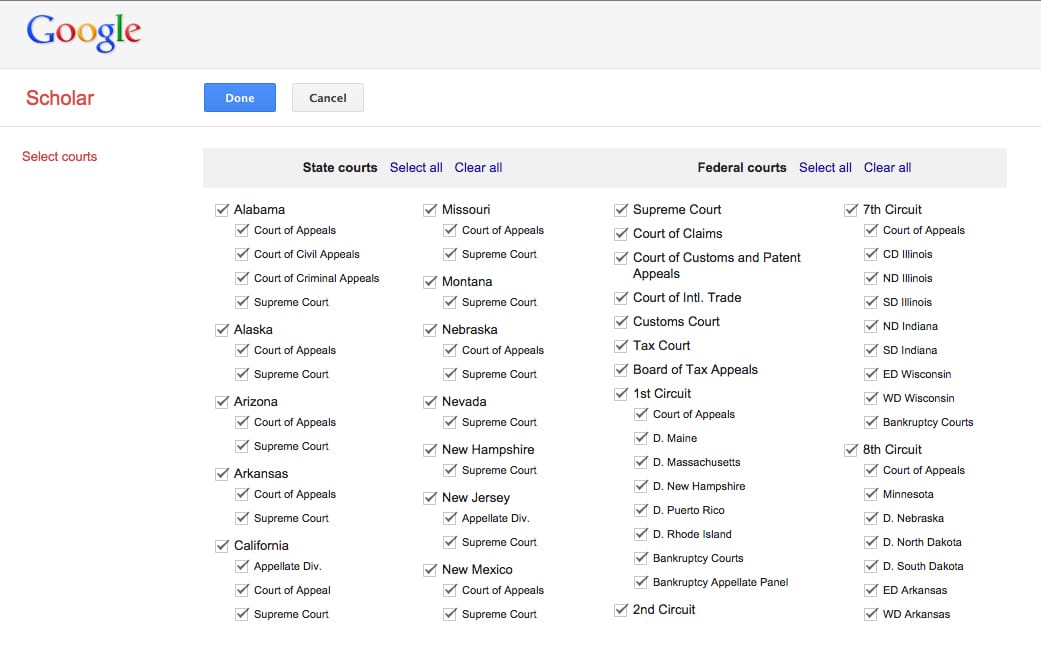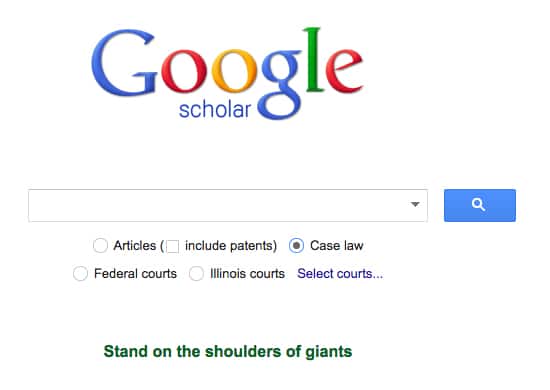If you are seeking ways to reduce your legal research costs, here is one good option: Google Scholar. It is an online research service you can use to find cases and secondary sources for free. If you want to know how to harness the power of Google Scholar — and impress your colleagues and clients with your stellar research skills — here are five good tips to get you started.
1. Extensive database of cases. Google Scholar has an extensive database of reported cases from state and federal courts. The database covers cases from the United States Supreme Court (since 1791), the U.S. Courts of Appeals and U.S. District Courts (since 1923), and supreme courts and intermediate appellate courts from all states (since 1950). If you can’t find any relevant cases within those date ranges, you probably should consider settling your lawsuit.
2. Reliable search algorithm and advanced searching. Google’s effective search algorithm powers Google Scholar. When searching for federal and state cases using keywords, the relevancy of the results is comparable to the results on WestlawNext and Lexis Advance (but let that be our little secret). Like those paid services, Google Scholar will likely return relevant results even if you do not use the proper terms of art.
Google Scholar also allows you to filter search results by date and court. For example, you can keyword search cases only from the Sixth Circuit or only from the Kentucky Supreme Court (or any other state court). You can also limit the search results to cases that were decided after a certain year. This filtering tool will help you avoid the awkward question from your judge, “Counsel, why did you cite an Arizona case for a rule on Kentucky tort law?”

3. Useful proximity connector. Most free services don’t allow users to run searches where various terms appear in the same sentence or paragraph. But Google Scholar has one proximity connector: AROUND. Apparently, Google wants only the “in-crowd” to know about this search functionality; in fact, it does not even mention the connector “AROUND” on the official Google Scholar Blog.
After experimenting with this proximity connector, I learned a few useful things. First, you can use “AROUND” to search for a term only when it appears after another term. For example, assume you need to find federal cases addressing when the police may conduct a Terry stop based on a suspected misdemeanor crime. One search string could be “Terry AROUND(15) stop AROUND(15) misdemeanor.” In that string, Google Scholar will search for cases where “stop” appears within 15 words after “Terry” and “misdemeanor” appears within 15 words after “Terry” and “stop.” It will not find cases where “misdemeanor” appears before “Terry” or “stop.” Second, you must capitalize “AROUND,” have no space between it and the parenthetical, and include quotation marks around the entire search string. Without quotation marks, Google will run a natural language search. Third, the connector “AROUND” does not work for phrases. Thus, if you used the search string “Terry stop AROUND(15) misdemeanor,” you will receive no results.
4. Citation service for cases. Google Scholar has a citation service that allows you to find subsequent cases and legal articles that have cited your case. By default, the results are organized based on depth of discussion — meaning the first listed results have discussed your case in more detail than later results. The depth of discussion is represented by horizontal bars next to each case name: the more bars, the greater the discussion of your case. You can also sort the results by date — a useful feature for a familiar issue where you simply need to confirm whether any new case has addressed your issue.
5. Free secondary sources. Although Google Scholar has no database for secondary sources, you can use it to find legal articles hosted on other websites. Some sites are free and some require a paid subscription. For instance, if you searched for articles on Ohio tortious interference law, Google Scholar would provide links to articles on bepress (free), the Social Science Research Network (free) and HeinOnline (paid).
Note that despite my praise for Google Scholar, it does have limitations. So, while it’s an excellent addition, it isn’t a one-stop shop for your research needs.
Eric Voigt teaches legal research and writing at Faulkner University Jones School of Law. As the owner of R+W Legal Consultants, he develops and presents interactive CLE courses on becoming rock-star researchers and writers. Eric streams his popular courses online, allowing attorneys to earn CLE credit from the comfort of their home. He also blogs on how to persuade judges.






















